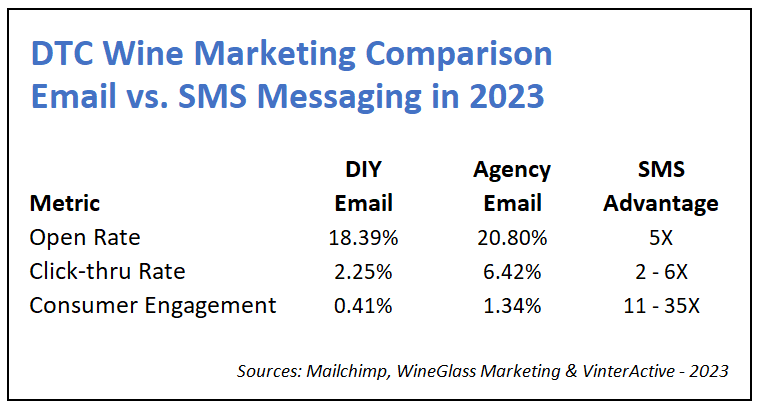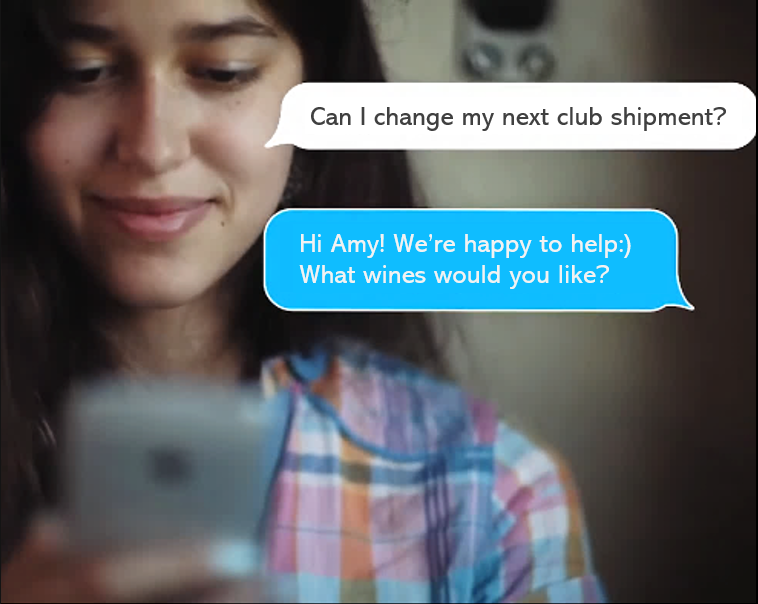It seems there was never a dull moment for wine merchants using SMS messaging in 2022.
First, telecom providers changed their rules, making it harder for wineries to text customers.
Then, many of the most popular SMS vendors abandoned the alcohol industry altogether, leaving hundreds of U.S. wineries and breweries searching for new SMS partners.
But despite these challenges, alcohol merchants texting their opt-in customers last year were richly rewarded with record-breaking sales and marketing results outperforming any other communication channel used in the wine industry.
ABOUT THIS REPORT
VinterActive’s 2023 VinQuest™ SMS Wine Marketing Report is based on the performance of over 300 SMS wine messaging campaigns sent to more than 100,000 opt-in wine and beer consumers in 2022. For comparison, this analysis also incorporates the results of millions of wine marketing emails sent to consumers in 2022.
2023 WINE MARKETING BENCHMARKS – EMAIL VS. SMS
Compared to the wine industry standard – email marketing – alcohol merchants using text messaging enjoyed up to 35 times more customer engagement for each text message they sent in 2022.
Although email marketing still generates positive ROI for many merchants, text messages sent by wine brands in 2022 were 5.5 times more likely to be opened and 6.5 times more likely to be clicked than a typical DIY email campaign.
To put these results in perspective, a list of 300 SMS contacts can generate the same results as a list of 10,000 email addresses.
While wine merchants with the resources to employ the services of professional email marketing agencies fared 3-times better than DIY wine marketers in 2022, SMS messaging still outperformed the best efforts of today’s top email marketers 10-to-1.
2023 SMS WINE MARKETING ANALYSIS
This year’s results compare favorably with industry-wide estimates that report a 20-to-1 advantage for text marketing compared to email. The results reported by wine marketers over the last two years may indicate that consumers are more amenable to text messages sent by their favorite wine brands.
Or, since the wine industry is still relatively new to SMS messaging, initial results might temper over time as more merchants adopt texting and the wine industry starts to look more like other retail segments.
But whether text messaging drives 10 times or 30 times more customer engagement compared to current industry practices, the results of this analysis mean savvy wine businesses would be foolish to ignore this game-changing DTC marketing breakthrough.
BEST PRACTICES OF SMS WINE MARKETING IN 2023
For the innovators using text messaging in the wine industry, best practices continue to evolve for merchants focusing on the three pillars of SMS marketing success:
Growing compliant SMS lists
Sending customer-triggered text marketing campaigns
Managing 2-way text conversations with consumers
BEST PRACTICES FOR LIST GROWTH
In 2023, alcohol marketers using text messages to stay in touch with customers MUST employ age gates to deter underage consumers from joining their SMS lists.
And since the best opt-in method is still express written consent when consumers must check a box or enter a code to subscribe, today’s most successful SMS wine marketers are successfully building their opt-in lists using:
Preference-Based Online Signup Forms that collect new subscribers’ DOB and ask about customer interests so future messages will better support customer needs
Opt-in Keywords configured with automated age gates that consumers can use to request SMS wine messages
Email Marketing campaigns offering age-verified customers the opportunity to request SMS notifications about pending shipments, tasting events, and upcoming reservations
Preference-based messaging targeting opt-in contacts is the best way to maximize customer satisfaction and sales.
BEST PRACTICES FOR OUTBOUND SMS CAMPAIGNS
In 2022, successful SMS wine marketers focused on outbound text campaigns targeting distinct customer segments with messages valued by customers because they meet an important need.
Some of the most successful outbound campaigns we measured last year were:
• Preference-Based Content Streams that use customer preferences to deliver weekly or bi-weekly content, like upcoming events or new wine releases
• Transactional Texts triggered by customer behavior to send order/shipping notifications and reservation confirmations
• Personalized Sales Offers that use purchase history and customer tags to trigger sales offers customized for each consumer
PRO-TIP: For maximum results and efficiency, stick to a regular cadence of text messaging synced with your social media and email marketing calendars.
BEST PRACTICES
FOR 2-WAY TEXTING
For many wineries, once they start texting their customers, their biggest fans start texting back – opening a new inside sales channel powered by 2-way text conversations.
As a result, entire hospitality teams are turning to text messaging to communicate with customers conveniently, answer questions in real-time, delight guests with personalized service, and sell more wine as a result.
2-way texting opens a new channel for delivering customer service & maxmizing DTC sales
In 2022, the best practices we observed for managing 2-way text conversations were:
Creating Keyword Triggers customers can use to answer frequently asked questions
Adding “Text Us” Buttons to website pages inviting customer engagement via text
Using Group Notifications to update staff as new text messages are received
THE FUTURE OF TEXT MARKETING IN THE WINE INDUSTRY
2022 was a pivotal year that could have ended the use of text messaging in the U.S. wine industry. But instead, SMS wine marketing became more viable than ever due to the combined efforts of its primary stakeholders: mobile carriers, SMS service providers, and DTC wine marketers.
Since SMS wine marketing is still so new and continues to produce game-changing results, it seems reasonable to expect a high rate of innovation in the foreseeable future.
Mobile carriers will likely continue honing the vetting process all merchants must undergo before texting customers. SMS service providers will continue creating the next generation of age verification tools and are already developing AI to improve SMS performance without requiring more work from winery staff.
And some of the best direct marketers in the wine industry are already cultivating this year’s crop of SMS best practices as they continue to profit from text messaging.
So the future of text marketing in the wine industry still shines brighter than ever In 2023.
Even though wine marketing is one of history’s oldest professions, it’s evolving so quickly that we can all look forward to what the future holds.
THE BOTTOM LINE ON
SMS WINE MARKETING
SMS wine marketing still seems much like email marketing 20 years ago, with innovative vintners reporting astonishing results that were hard to believe at first but finally fueled the wine industry’s first wave of digital marketing success.
Perhaps we’ll continue to see another wave building in 2023.
In a world where 90% of online consumers want text messages from their favorite brands, but fewer than 10% of U.S. wineries text their customers, this epic mismatch between consumer preference and industry practice spells nothing but opportunity for alcohol merchants focused on growth.
And unless you think text messaging is going away soon, the only choice you have to make is whether you let your competition profit from text messaging before you.
With consumers hungry for brands that engage them with text messaging – and wine marketers looking to better connect with a new generation of customers – we hope the benchmarks and best practices we’ve shared in this report can help any wine business profit from SMS messaging in 2023.
Happy Selling!
ABOUT THE AUTHOR
Founder & CEO of VinterActive, Bryan St. Amant, is a pioneer in developing preference-based direct marketing and its successful application in the wine industry. His advice has helped hundreds of wineries across the U.S. grow sales and customer satisfaction by leveraging the best practices of DTC wine marketing.
Bryan St. Amant holds an MS from M.I.T. and a BS from U.C. Berkeley. His award-winning work has been featured in books, magazines, and seminars, including CFO Magazine, Inc., CNN Money, eMarketing Magazine, Integrated Direct Marketing, Direct Marketing Association, Wine Marketing Report, Grapevine Magazine, and the Wine Industry Network.






